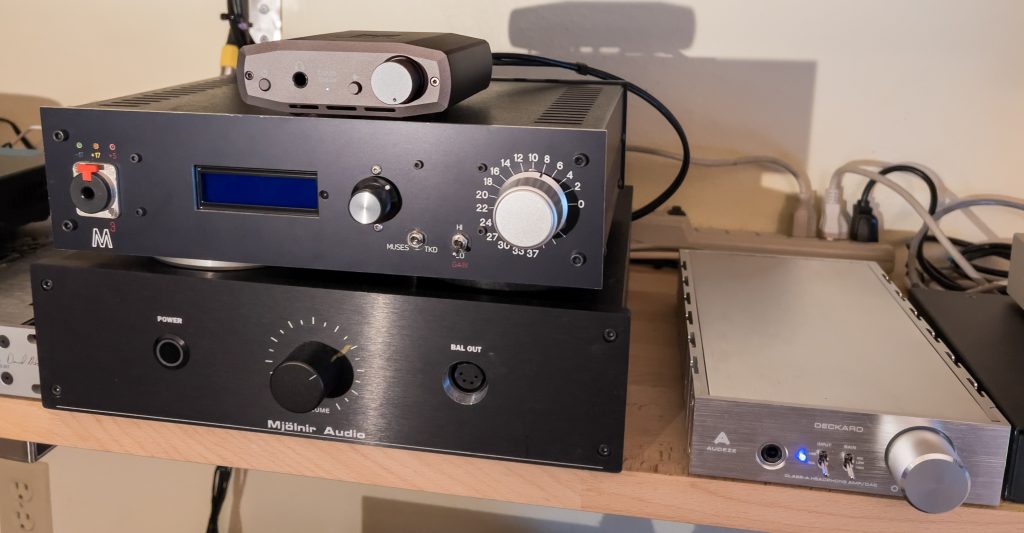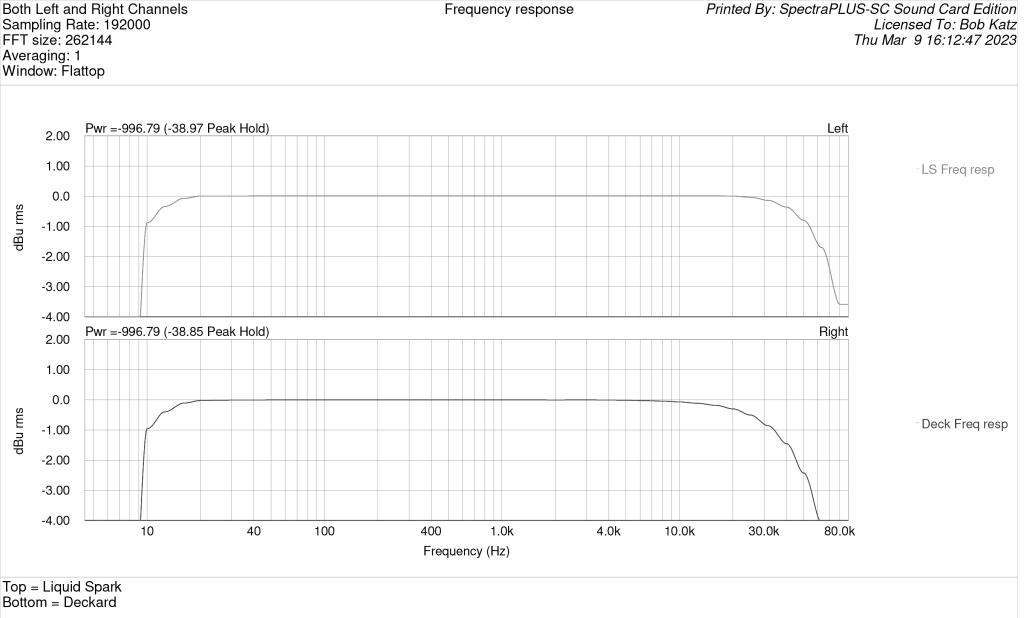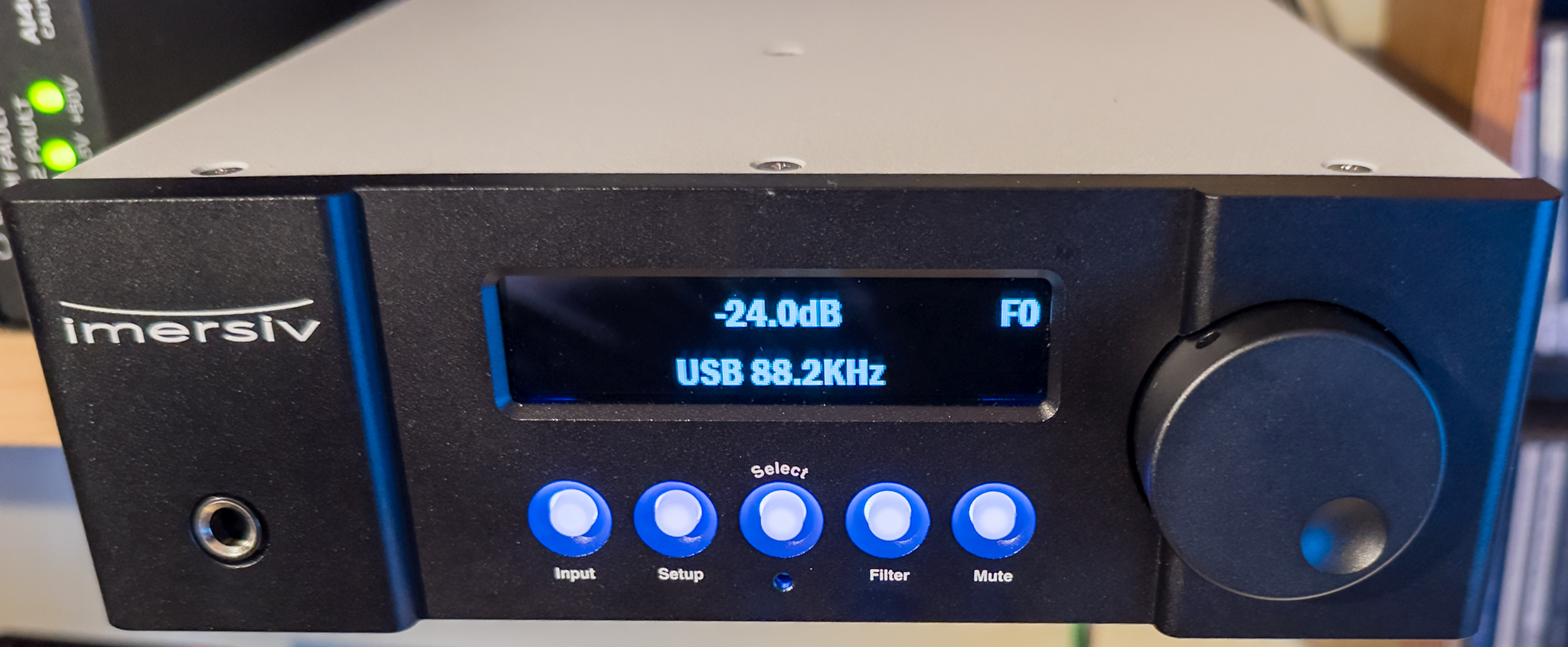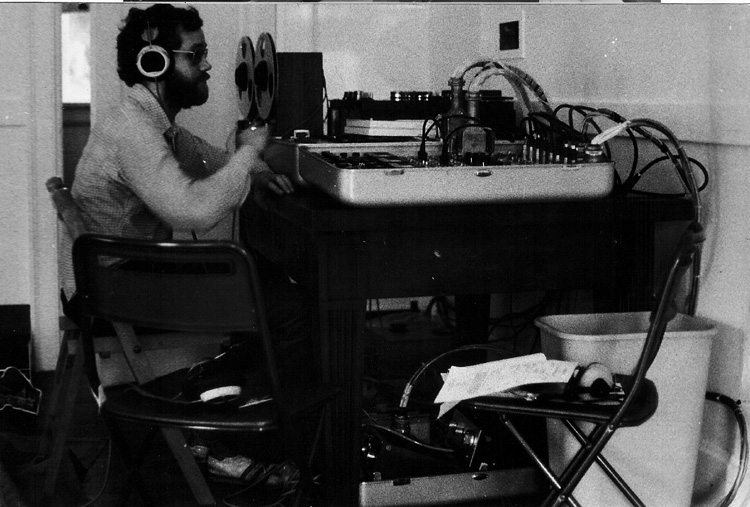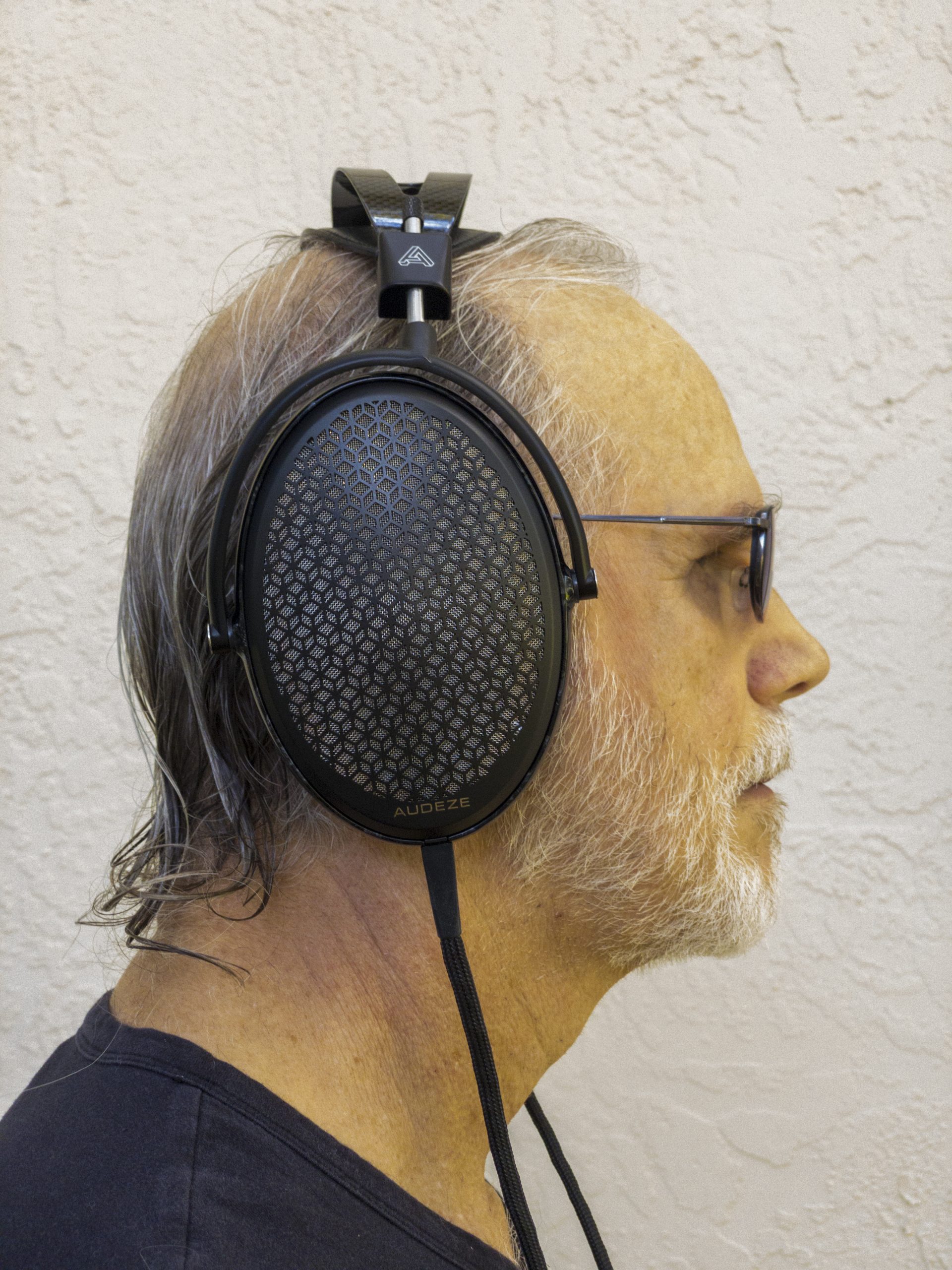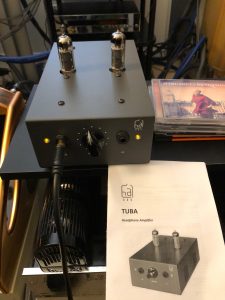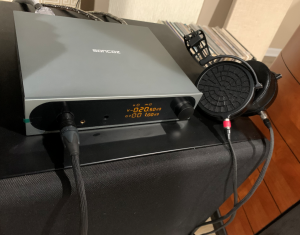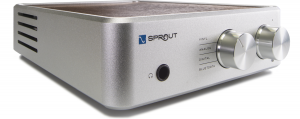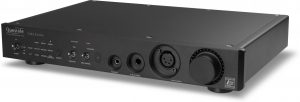Headphone stuff comes up in my email feed all the time! Last week I received a notice from online bargain store Monoprice that an "audiophile" headphone amplifier, normally priced at $129.99, is on special for $67.99—the Monoprice Monolith Series Liquid Spark. Oh, come on! An "audiophile-quality" headphone amp at a bargain-basement price? This put me on guard since my previous experience with a bargain headphone amp was very disappointing: the wimpy-sounding JDS O2 amp. Now this from Monoprice: the same store that sold me cheap Ethernet cables that don't latch in place because the lock tab breaks off! I've bought other selected items from Monoprice (mostly computer/USB stuff) and been pretty happy, but I must tell you: caveat emptor—many of this online store's items are less than top-notch. As they say, "cheap, and built to stay that way." However, Monoprice's blurb looked very intriguing: Designed by Dr. Alex Cavalli (who I had not heard of to this point), direct coupled (no capacitors), discrete (no opamps), 36-volt DC power supply. Yeah, made in China, but not every Chinese piece is junk. So, crossing fingers, I couldn't resist and ordered the Liquid Spark.
The Liquid Spark ("LS" for short) arrived within two days, thanks to Monoprice's unparalleled speedy service. It was plainly but securely packed. The front face looks pretty actually; it's curvy, definitely not a plain looking box. Physically, LS is quite small compared to the humongous audiophile headphone amps that I own. In this photo, the Liquid Spark is dwarfed by a custom-built AMB M3 amplifier and a Mjolnir Audio amp, and to the right the Audeze Deckard.
BIGGER IS NOT BETTER
LS uses an outboard universal switching single-ended 36-volt DC power supply with coax connector. This means that in order to be direct coupled, an amplifier must internally derive a bipolar supply with a center point as ground. Some small voltage drop is to be expected, but to be sure, a 36-volt swing is enough to drive any dynamic headphone to smithereens. Very promising. At this price, we get bargain-basement unbalanced RCA inputs and unbalanced 1/4" output. How long the cheap connectors will last is another story, of course. There are also two unbalanced preamp outputs, which I did not test.
The most difficult headphones to drive are high impedance models like the Sennheisers, which require significant voltage drive. So first I put the LS to an "is it loud enough?" test, feeding it from my Prism Sound Callia DAC at its maximum output (2 V RMS at 0 dBFS, the same level as classic CD players). In the low gain setting the LS had enough level to drive my HD 600 to a reasonable loudness, but only at the very top of the LS volume control. So for very low level material, or just to play a little louder, I engaged the high gain setting for these cans. I didn't spend much time listening to the Sennheisers, because to be honest, I have long ago fallen out of love with them. The HD 600s drive like my old Ford Explorer: gets you there, slowly, and sluggishly. All I can say is if you are a fan of high impedance phones, the LS has enough level to drive them. End of that story.
Next, I moved up to a couple of my Audeze planar-magnetics and prepared a boxing match against one of my favorite headphone amps of all time: the highly-revered Audeze Deckard. Long out of production, the powerful all-discrete Class A Deckard was truly a bargain in its time, selling for $699 including an internal USB DAC. The Deckard has enormous heatsinks that idle at 96 degrees F (which I just measured). I think the Deckard was underpriced, as it's built like a tank: its sound quality is big, clean, powerful, spacious and warm. I wish Audeze would revive the Deckard: even at twice the price it would be an incredible reference amp. Using two RCA Y adapters, I fed the Callia DAC to both the LS and the Deckard, and matched both amps within 0.1 dB using my trusty Fluke voltmeter and a 1 kHz digitally-generated sine wave. From that point I did not touch the analog volume controls and used Acourate Convolver's high resolution dithered digital volume control. Acourate Convolver can be found HERE.
Disclaimer: I have personally purchased most of my headphones, but recently I have been creating headphone equalizations for Audeze, which provides me phones for testing. Starting with the best planar magnetic phone Audeze currently makes, the LCD-5, I inserted Bob's LCD-5 EQ in Acourate Convolver, and started by playing Lindsey Webster's "Back To Your Heart", from the smooth jazz album of the same name that I mastered. I played my original 24/96 master file in JRiver Media Center. I engineered this piece to rock and punch—obviously I'm very familiar with how it sounds on my reference mastering loudspeakers.
Moving the LCD-5 back and forth between the level-matched Deckard and the LS, I felt that the Deckard sounded a bit warmer and fuller, but the LS definitely did not disappoint: It produces an excellent wide soundstage, clarity with impact, warmth, and bass extension. Lindsey's voice retains the bottom and clarity that I know is there. This was with the LS in the high gain setting, so I decided to switch the LS to low gain, as that would remove an extra stage of amplification. Then I subjectively matched the loudness of the two amplifiers using their individual volume controls. At that point, I felt that the LS in the low gain position sounds a bit warmer and fuller, considerably closer to the sound of the Deckard. In fact, the two amps now sounded so close that if I changed the volume control of either one by a pinch, I could easily make the louder amp sound better! This points out that loudness differences rule, so if you are going to critically compare anything, you must do it at precisely matched level.
Having preferred the low gain setting for the LS, I scientifically matched the levels of the two amplifiers at 1kHz, and did not touch their individual volume controls for the rest of the review. All volume control was performed in Acourate Convolver, which also provided Bob's headphone EQs.
Next song up was my master of Livingston Taylor, "Isn't She Lovely," which I recorded for Chesky Records, playing the original 24/96 master file. On the LS, Livingston's voice sounded nicely dynamic, impacting, and clear. Switching over to the Deckard he sounded a hair more attractive, fuller, and warmer, but not so much better that I would feel cheated using an amp costing 1/10th the price! On both amps, the guitars are warm and sweet, as I had engineered them years ago. Although the LS sounds a bit more forward than the Deckard, it really can hold its own. However, Livingston whistles a few times during this song, and these high-pitched whistles should sound bright, but not harsh. But they did sound a bit strident on both amps—a bit more harsh on the LS than the Deckard. But let's keep in mind that I developed my LCD-5 EQ using the warmer-sounding Deckard amp. So, the next thing I did was insert a subtle HF rolloff in Acourate Convolver, flat at 10k, -0.6 at 20k. Why and how did I arrive at this rolloff? You'll find out in the Measurements section (below). Once I inserted this HF rolloff, Livingston's whistles no longer sounded strident on the LS, he sounded sweet and natural, without losing any clarity or HF extension.
Next up, a salsa song that I mastered called "Mambo Dalegria," by Maria Dalegria. Forgive me for referencing a song that's not publicly available, but this is one of my references for brass and percussion, which can easily sound harsh on the wrong amplifier. For this song I switched to my Audeze MM-500 (Manny Maroquin phones), which I think are the best price-performance ratio out there, costing about $1500 as opposed to the $4000+ LCD-5's. The MM-500s would need their own EQ, that I have not yet developed, but they are in the same design family as the LCD-5s, so I used my LCD-5 EQ as a basis. With the warmer MM-500s I was able to remove the extra 20 kHz rolloff. The MM-500 are much more sensitive than the LCD-5, and are definitely warmer and fuller than the LCD-5, but they also are less revealing. Nevertheless, the MM-500 is very pleasant sounding and quite accurate in its price range. With the less-revealing MM-500s I really had difficulty distinguishing between these two amps.
Back to the LCD-5, switching back and forth between the level-matched LS and Deckard, I realized that the Deckard has a slightly more robust, fuller bottom end than the LS. This is despite both amps being direct coupled, and measure identically flat from below 20Hz (as we will learn in the measurement section below). I believe the explanation for this sonic difference is in the power supply: the Deckard must have a stiffer, better regulated power supply. At ten times the price I would expect a better supply! This means that sustained bass notes and louder bass moments may slightly deplete the LS power supply a bit, weakening the loudness of longer notes or impact of loud momentary transients. It turns out a good band-aid for a subtle power supply problem is to apply a little bass boost: this raises the average bass level but it also raises the power of the bass. EQ is not as authentic as a power supply fix, but for a subtle problem I found it can be quite effective. For me, just 0.2 dB of bass boost below 100Hz leveled the playing field and made the LS sound much closer to the Deckard: Now we have a real boxing match! This EQ does not make the LS amp wimp out; it easily takes the extra bass without strain. In due time I'll take the LS to the test bench and try adding a little capacitive reservoir to help sustain the bass during momentary transients, for the most accurate reproduction.
Next up, Marley's Ghost, "Religion in Rhythm," from the 2006 Spooked album, mastered by yours truly, using my 2496 master file. Ghost is an Americana group with fabulous harmony singing and instrumental performance. I found with the compensating bass boost and treble rolloff, the LS sounded solid, pure, and extended, with excellent separation and soundstage. The string bass had excellent weight. With the compensating EQ, I think the Deckard and the LS are now quite evenly matched. I'll call this boxing match a draw and concentrate on what the LS itself can do with other music sources.
Next, I switched to Qobuz as the music source, opening up to the wide world of music. I used the same EQ settings in Acourate Convolver. First up, John Williams: The Berlin Concert, on Deutsche Grammophon. The orchestra sounds big, rich, spacious, and clear! I was so hooked by the sound of this album on the LS that I just sat had to sit back and listen to the whole album, from the Olympic Fanfare to various film selections. Man, glorious! This sounds like a world-class system: I can't believe I'm listening to a $68 headphone amplifier!
I'm kind of disappointed that Qobuz has not yet listed my mastering credit on Judith Owen's fabulous album Come On & Get It, a blues tour de force by this sexy singer. Look her up on Qobuz or Tidal; you will not be disappointed. "Blossom's Blues" sounds clear, natural, and full, from the string bass to the vibrant New Orleans trumpet. The album ranges from jazz big band to small ensembles encircling Judith's voice. You'll laugh at all the double-entendres in these down-and-dirty blues songs.
Yes folks, I like a lot of music styles. So if you're a fan of good sounding metal-rock, Deafheaven is the real deal. An experimental progressive metal band available at 24/96 on Qobuz or Tidal, this album is quite pleasant, surprisingly audiophile-quality. It sounds clear and spacious on the LS with the LCD-5's.
I've created a Playlist of some of the best-sounding high-res music I've found on Qobuz ( HERE). Here are some other selections on this multi-genre list:
One of my best jazz finds is the live album Chronology of a Dream: Live At the Village Vanguard, by the Jon Batiste Band. The initial cut, called "BLACCK", sounds impacting and very alive. The best musicians on earth are on fire. It's warm, clear, spacious, and deep.... the LS amp perfectly delivers this fabulous recording.
Switching to Broadway (I told you I like a lot of genres), the original London cast of Calendar Girls, playing on Qobuz at 24/96. This recording is the epitome of the Broadway art: strings, brass, percussion, lead vocals, chorus. Great fun in stereo. On the LS it sounds warm, pure, spacious, and extended.
Another of my favorites is "Natural Mystic" by Bob Marley, on the Exodus album, an excellent recording available at 24/96 on Qobuz. The deep electric reggae bass drives well on the LS and the stereo mix is very spacious and entertaining.
The late Dr. John is well-represented with "Mama Roux", from the classic Gris Gris album, recorded in 1968, with a beautiful transfer and restoration of this classic album available on Qobuz.
One of Alison Krause's best-sounding albums is New Favorite, and one of its most enchanting selections in the playlist is "Let Me Touch You." Her beautiful voice is accompanied by bluegrass royalty and royally reproduced on the LS.
Bottom line
Clearly the little $68 Liquid Spark headphone amp boxes well above its weight. It sounds great even without EQ. Then, with very slight EQ, it can subjectively equal or at least approach the sound of the highly revered Audeze Deckard. In my opinion, you don't need a $4000 headphone amp to satisfactorily drive a $4000 headphone.
Measurements and Technical Comments
For the Deckard I used medium gain and did not measure at any other gain setting.
Gain in low position
- Liquid Spark: With a Hi Z load and volume control up full, low gain position is approximately unity gain. I measured a slight loss, -0.21 dB gain at 1 kHz.
Volume Control Tracking
Checking a vocal center image I rotated the volume control. The image remains subjectively centered down to about 10 o'clock, which I think is more than satisfactory, especially for a budget piece.
THD
I measure using THD without noise… it makes no sense to me to include noise in a measurement when modern analyzers can isolate the distortion components from the noise. For analysis I use Spectraplus, HERE and in this case a Grimm UC-1 interface HERE.
THD at 1 kHz at 0 dBu into high impedance load
Liquid Spark: 1 kHz THD 0.0014/0.0017% (left channel/right channel)
Deckard: 1 kHz THD 0.0012/0.0014%
The two amplifier’s THD measure almost identically. I strongly doubt that the slight difference of 2 or 3 10-thousandths of a percentage point harmonic distortion has anything to do with the subtle sonic differences between these two amps.
THD at 1 kHz at 0 dBu into 20 ohms
Liquid Spark: 1 kHz THD at 0 dBu 20 ohm load 0.004/0.003%, slight increase in THD compared to Hi-Z load
Deckard: 1 kHz THD at 0 dBu 20 ohm load 0.001/0.001, about the same as Hi Z
THD at 1 kHz at 0 dBu into 110 ohms
- Liquid Spark: 0.001%/0.001%, same as high Z
Noise (LS at low gain)
- Liquid Spark: Noise wideband unweighted through 96kHz: -36/-36 dBu
- Deckard: Noise wideband unweighted through 96kHz -36.5/-36.5 dBu, nearly identical
These are not exemplary noise measurements, but most of this noise is out of the audible band.
- Liquid Spark: Noise 20-20k unweighted -80.6/-82.8 dBu (much better when you limit the measurement bandwidth)
- Deckard: Noise 20-20k unweighted -82.4/-79 dBu
- Liquid Spark: Noise 20-20k A Weighted -88.1/-87.3 dBu
- Deckard: Noise 20-20k A Weighted -85.8/-83.8 dBu
Liquid Spark high gain
- Into Hi Z load high gain, volume control up full > 5.8 dB gain, which is almost a 6 dB boost. The manufacturer specification is +3 dB but this choice of +6 dB is much more useful.
- THD 1kHz 0.0014/0.0017%, the same as low gain.
- Noise wideband unweighted -36/-36 dBu, same as low gain.
- Noise 20-20k unweighted -80/-81 dBu, about the same as low gain.
- Noise 20-20k A Weighted -86.4/-86.2 barely measurable difference: slightly higher noise at high gain than low gain.
Output Impedance
- Liquid Spark: Output impedance at 1kHz, calculated with a 20 ohm load, 0.73 ohms.
- Deckard: Output impedance at 1kHz, calculated with a 20 ohm load, 0.35 ohms
These are both excellent specs, extremely low output impedance.
IMD, 19-20 kHz, 110-ohm load at low gain
- Liquid Spark: IMD 19-20kHz at -3.25 dBu. No evidence of difference tones or additional tones, 0.02/0.02% (EXTREMELY LOW)
- Deckard: IMD 19-20kHz at -3.4 dBu. No evidence of difference tones or additional tones, 0.05/0.05% (EXTREMELY LOW IM DISTORTION)
Freq response
- Liquid Spark: -1 at 10Hz, flat 20-20k, -3 @ 75kHz. Very wideband response.
- Deckard: -1 at 10Hz, flat 20-10k, -0.3 at 20k, -3 at 58kHz. Slight HF rolloff and significantly lower HF bandwidth than the LS.
FREQUENCY RESP LS VS DECKARD
I measure frequency response at 1/3 octave intervals, hence the jagged nature of the display curves. Measurement began at 10Hz, where both amplifiers have only a 1 dB rolloff, so likely they are both direct coupled. At the high end, the Deckard has a bit of a high frequency rolloff and rolls off at a lower supersonic frequency than the Liquid Spark. While the LS measures ruler flat to at least 20kHz. Is this rolloff the reason for the slightly warmer sound quality of the Deckard? As described in the review, adding a slight high frequency rolloff to the Liquid Spark similar to that in the Deckard makes the LS sound warmer and much closer to the sound of the Deckard.
Maximum Power Output (Clipping Point)
I use a 20-ohm test load, because many of today's headphones have impedances in that range or lower. Both amps go into clipping fairly steeply, so it's very hard to decide exactly what the clipping point is. Many say to use 1% THD as the clipping point, but I couldn't even approach 1% without seeing so many harmonics the FFT screen was so dense it was black. So, I decided it's much fairer to use a conservative figure, say around 0.01% THD as the maximum power output of the amplifier into a 20-ohm load. Each amplifier can actually deliver much higher power, and I imagine for short durations, the short-term distortion would not be noticed.
Liquid Spark produces 0.011% THD at 1kHz into 20 Ohms at +16 dBu = 4.89 V = 1.2 watts. This is very close to the spec, which is 1.3 watts at 50 ohms, equivalent to 5.1 volts.
Deckard produces 0.013% THD at 1kHz into 20 ohms at +16 dBu = 4.89 V = 1.2 watts. This is approximately equivalent to the factory spec of 795 mw at 33 ohms, or 5.1 volts. That's why using watts is so much less useful than comparing voltage swing capability.
How important is it in the real world to have a headphone amp that can deliver 1.2 watts with very low distortion? Let's put this value into perspective. Power is the silliest way to describe headphone sensitivity and headphone amplifier output, because we have to jump through hoops to figure out the SPL and compare the output levels of headphones that have different impedances. So I'll jump through the hoops for you! I'll convert all the headphone and amplifier specs to the common language of decibels, with 0 dBu = 0.7746 volts at the rated impedance. Then all we need is to use simple addition or subtraction to compare headphone sensitivities and output levels. For example:
What SPL can the LCD-5 deliver with 1.2 watts of power at 1kHz? LCD-5 sensitivity is 90 dB SPL/1 mW, and manufacturer's stated impedance is 14 ohms. That would be 0.118 volts, which is -16.3 dBu. Using the common language of decibels, we know that the amplifier can deliver about +16 dBu with low distortion, which is about 32 dB higher than the level which would deliver 90 dB SPL! Add 90 to 32 = 122 dB SPL! This means that our amplifier can deliver 122 dB SPL, so it's hard to determine which would melt first, our ear drums or the headphone diaphragms, but certainly not the amplifier!
So why do we want such tremendous amplifier power if it would produce way too loud sound? The answer: Because we need short term headroom. When an amplifier has headroom for momentary peaks it sounds cleaner and more dynamic. We probably don't need 122 dB SPL capability, 110 would probably be more than sufficient, as some extremely dynamic material has a peak to loudness ratio greater than 20 dB. For example, if we play at 80 dB SPL average, some peaks may reach as high as 100 dB or higher. The rest of it is specsmanship, or conservative engineering, or perhaps we actually need more headroom than the music can deliver for an amplifier to sound effortless, dynamic and clean.
Let's put this information into a table for three common headphones:
|
Headphone |
SPL, 1 kHz, with Liquid Spark or Deckard amplifier at maximum power (0.01% THD) |
|
Audeze LCD-4 |
118 dB |
|
Audeze LCD-5 |
122 dB |
|
Audeze MM-500 |
131 dB |
Calculations
- LCD-4: Sensitivity 97 dB/1 mW, impedance 200 ohms. This is considered a very difficult headphone to drive. Although I did not measure the amplifier's distortion into 200 ohms, it's a safe bet that it can deliver a little higher voltage into a higher impedance. But let's use the +16 dBu spec and see what we get: 1 mW is 0.447 volts or -4.8 dBu for 97 dB SPL. The amplifier can easily deliver +16 dBu, so, rounding to the nearest dB: 97 + 5 + 16 = 118 dB SPL. I guess the LCD-4 is not so hard to drive if you have a Liquid Spark or a Deckard!
- MM-500: Sensitivity 100 dB/1 mW, impedance 18 ohms. 1 mW is 0.134 V or -15.2 dBu for 100 dB SPL. The amplifier can deliver +16 dBu, so 100 + 15.2 + 16 = 131.2 dB SPL! This means that the MM-500 will play almost 10 dB louder than the LCD-5 or 14 dB louder than the LCD-4 with the same drive voltage! The MM-500 is a very sensitive headphone that can easily play loudly and be driven by just about any headphone amplifier.
Using the common language of decibels makes this whole thing so much easier to understand. Don't you wish that amplifier output and headphone sensitivity were all rated in a common decibel unit instead of these incompatible linear units! Write your congressperson.
This next image compares the clip point (at 1kHz) of the LS versus the Deckard. As you can see, both amps produce almost the identical distortion spectrum, indicating that they probably use similar discrete component topology.
CLIP POINT LS VS DECKARD
Crosstalk
- Liquid Spark: Crosstalk left to right, into a Hi Z load is an amazing consistent -78 dB from 10 Hz to well above 20kHz. Above 50kHz, the measurement rises to 38 dB due to rising noise floor in the Grimm noise shaped ADC which I use for analysis
- Deckard: Crosstalk left to right, Hi Z load is as good as the noise floor, 88 dB to 2kHz, rising to 68 at 20k, and 38 dB above 50kHz due to ADC's rising noise floor
- Liquid Spark: Crosstalk left to right, 20-ohm load is an acceptable 60 dB 10Hz to 50khz, above which it rises to 38 dB due to rising noise floor in the Grimm noise shaped ADC
- Deckard: Crosstalk left to right, 20-ohm load is an acceptable 56 dB 10Hz to 50 kHz, rising to 38 dB due to rising noise floor
Crosstalk right to left is reasonably symmetrical to left to right for both amps.
Polarity test = non inverting, for both amps
Original cost: Audeze Deckard $700 (which included DAC)
Liquid Spark: $67.99 on special for approximately the month of March at Monoprice.com
ADDENDUM
The next day I couldn't resist taking the Liquid Spark to my tech bench. In less than an hour's time I added two 1000 microfarad/50 volt capacitors across the + and - 18 volt test points on the board.
The result: Magnificence! The Liquid Spark has gained additional bass punch, power, sustain and richness. I definitely do not need the bass boost anymore and it's possible I can get rid of all or most of the treble rolloff. My Liquid Spark is now infinitesimally close to the sound of the Audeze Deckard, all with less than $5.00 of additional parts.
Wow! A welterweight can compete with the heavyweights!




